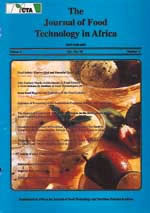
|
The Journal of Food Technology in Africa
Innovative Institutional Communications
ISSN: 1028-6098
Vol. 6, No. 3, 2001, pp. 104-108
|
 Bioline Code: ft01028
Bioline Code: ft01028
Full paper language: English
Document type: Research Article
Document available free of charge
|
|
|
The Journal of Food Technology in Africa, Vol. 6, No. 3, 2001, pp. 104-108
| en |
Chemical and nutritional properties of 'tej', an indigenous Ethiopian honey wine: variations within and between production units.
Bekele Bahiru , Tetenike Mehari , Mogessie Ashenafi
Abstract
A total of 200 samples of 'tej', an indigenous Ethiopian honey
wine, were collected from ten production units at different production times.
The pH values of samples varied between 3.07 and 4.90 and 77% of the samples had
pH values <4.0. Difference in pH value among all samples was significant
(p<0.01). The range for titratable acidity was 0.1 g/l00ml to 1.03 g/l00ml
and mean values for the different production units were 0.34 - 0.6 g/l00ml.
About 65% of the samples had titratable acidity values of 4 g/l00ml and
variations within samples of production units (CV>10%) or among all samples
(p<0.01) were significant. Mean total alcohol content for the various
production units was 6.98% -10.9%. About 58% of the samples had alcohol
content of 5 - 10%. Fusel oil content of samples ranged between 0.1 g/l00L and
88 g/l00L. Mean values for the production units were 13.6 - 27.4 g/l00L. About
50% of the samples had fusel oil content of >20 g/l00L. Variation in total
alcohol and fusel oil content within samples of production units was significant
(CV>l0%) and difference in these values were also significant (p<0.0l).
Mean values for total carbohydrate, total lipid, total protein and reducing
sugars were 1.49-3.73 mg/ml, <1.00 mg/ml, 0.33-4.66 mg/ml and 0.46-2.09
mg/ml, respectively. Variations in these values within samples of production
units (CV>l0%) or among all samples (p<0.0l) were significant. As 'tej'
fermentation is a spontaneous process that depends on microflora naturally
present on the substrates and equipment, the different metabolic products of the
randomized microflora at different stages, the physical and chemical
environment, duration of fermentation and concoction practices would result in
physico-chemical variations in the final product.
|
| |
© Copyright 2001 The Journal of Food Technology in Africa, Nairobi
|
|
